ZHCSEN1A February 2016 – October 2016 TPS720-Q1
PRODUCTION DATA.
6 Specifications
6.1 Absolute Maximum Ratings
at TJ = –40°C to +125°C (unless otherwise noted); all voltages are with respect to GND(1)| MIN | MAX | UNIT | |||
|---|---|---|---|---|---|
| VIN(2) | Input voltage (steady-state) | –0.3 | VBIAS or 5(3) | V | |
| VIN_PEAK(4) | Peak transient input | 5.5 | V | ||
| VBIAS | Bias voltage | –0.3 | 6 | V | |
| VEN | Enable voltage | –0.3 | 6 | V | |
| VOUT | Output voltage | –0.3 | 5 | V | |
| IOUT | Peak output current | Internally limited | |||
| Output short-circuit duration | Indefinite | ||||
| PDISS | Total continuous power dissipation | See Thermal Information | |||
| TJ | Operating junction temperature | –55 | 125 | °C | |
| Tstg | Storage temperature | –55 | 150 | °C | |
(1) Stresses beyond those listed under Absolute Maximum Ratings may cause permanent damage to the device. These are stress ratings only, which do not imply functional operation of the device at these or any other conditions beyond those indicated under Recommended Operating Conditions. Exposure to absolute-maximum-rated conditions for extended periods may affect device reliability.
(2) To ensure proper device operation, VIN must be less than or equal to VBIAS under all conditions.
(3) Whichever is less.
(4) For durations no longer than 1 ms each, for a total of no more than 1000 occurrences over the lifetime of the device.
6.2 ESD Ratings
| VALUE | UNIT | |||
|---|---|---|---|---|
| V(ESD) | Electrostatic discharge | Human-body model (HBM), per ANSI/ESDA/JEDEC JS-001(1) | ±2000 | V |
| Charged-device model (CDM), per JEDEC specification JESD22-C101(2) | ±500 | |||
| Machine model (MM) | ±100 | |||
(1) JEDEC document JEP155 states that 500-V HBM allows safe manufacturing with a standard ESD control process.
(2) JEDEC document JEP157 states that 250-V CDM allows safe manufacturing with a standard ESD control process.
6.3 Recommended Operating Conditions
over operating junction temperature range (unless otherwise noted).| MIN | NOM | MAX | UNIT | ||
|---|---|---|---|---|---|
| VIN | Input voltage (steady-state) | 1.1 | VBIAS or 4.5(1) | V | |
| VBIAS | Bias voltage | 2.6 or VOUT + 1.4(2) | 5.5 | V | |
| VOUT | Output voltage | 0.9 | 3.6 | V | |
| IOUT | Peak output current | 0 | 350 | mA | |
| VEN | Enable voltage | 0 | 5.5 | V | |
| CIN | Input capacitance | 1 | µF | ||
| CBIAS | Bias capacitance | 0.1 | µF | ||
| COUT(3) | Output capacitance | 2.2 | µF | ||
(1) Whichever is less.
(2) Whichever is greater.
(3) Maximum ESR must be less than 250 mΩ.
6.4 Thermal Information
| THERMAL METRIC(1) | TPS720-Q1 | UNIT | |
|---|---|---|---|
| DRV (WSON) | |||
| 6 PINS | |||
| RθJA | Junction-to-ambient thermal resistance | 66.5 | °C/W |
| RθJC(top) | Junction-to-case (top) thermal resistance | 86.2 | °C/W |
| RθJB | Junction-to-board thermal resistance | 36.1 | °C/W |
| ψJT | Junction-to-top characterization parameter | 1.7 | °C/W |
| ψJB | Junction-to-board characterization parameter | 36.6 | °C/W |
| RθJC(bot) | Junction-to-case (bottom) thermal resistance | 7.4 | °C/W |
(1) For more information about traditional and new thermal metrics, see Semiconductor and IC Package Thermal Metrics (SPRA953).
6.5 Electrical Characteristics
over operating temperature range (TJ = –40°C to +125°C), VBIAS = (VOUT + 1.4 V ) or 2.6 V (whichever is greater), VIN ≥ VOUT + 0.5 V, IOUT = 1 mA, VEN = 1.1 V, and COUT = 2.2 μF (unless otherwise noted); typical values are at TJ = 25°C| PARAMETER | TEST CONDITIONS | MIN | TYP | MAX | UNIT | |||
|---|---|---|---|---|---|---|---|---|
| VIN | Input voltage | 1.1(1) | VBIAS or 4.5(2) | V | ||||
| VBIAS | Bias voltage | 2.6 | 5.5 | V | ||||
| VOUT(4) | Output voltage(3) | 0.9 | 3.6 | V | ||||
| Output accuracy | Over VBIAS, VIN, IOUT, TJ = –40°C to +125°C | VOUT + 1.4 V ≤ VBIAS ≤ 5.5 V, VOUT + 0.5 V ≤ VIN ≤ 4.5 V, 0 mA ≤ IOUT ≤ 350 mA |
–2% | 2% | ||||
| Over VBIAS, VIN, IOUT, TJ = –40°C to +125°C | VOUT + 1.4 V ≤ VBIAS ≤ 5.5 V, VOUT + 0.5 V ≤ VIN ≤ 4.5 V, 0 mA ≤ IOUT ≤ 350 mA, VOUT < 1.2 V |
–25 | 25 | mV | ||||
| VIN floating | VOUT + 1.4 V ≤ VBIAS ≤ 5.5 V, 0 μA ≤ IOUT ≤ 500 μA |
±1% | ||||||
| ΔVOUT/ΔVIN | VIN line regulation | VIN = (VOUT + 0.5 V) to 4.5 V, IOUT = 1 mA | 16 | μV/V | ||||
| ΔVOUT/ΔVBIAS | VBIAS line regulation | VBIAS = (VOUT + 1.4 V) or 2.6 V (whichever is greater) to 5.5 V, IOUT = 1 mA | 16 | μV/V | ||||
| VIN line transient | ΔVIN = 400 mV, tRISE = tFALL = 1 μs | ±200 | μV | |||||
| VBIAS line transient | ΔVBIAS = 600 mV, tRISE = tFALL = 1 μs | ±0.8 | mV | |||||
| ΔVOUT/ΔIOUT | Load regulation | 0 mA ≤ IOUT ≤ 350 mA (no load to full load) | –15 | μV/mA | ||||
| Load transient | 0 mA ≤ IOUT ≤ 350 mA, tRISE = tFALL = 1 μs | ±15 | mV | |||||
| VDO_IN | VIN dropout voltage(5) | VIN = VOUT(NOM) – 0.1 V, (VBIAS – VOUT(NOM)) = 1.4 V, IOUT = 350 mA |
110 | 200 | mV | |||
| VDO_BIAS | VBIAS dropout voltage(6) | VIN = VOUT(NOM) + 0.3 V, IOUT = 350 mA | 1.09 | 1.4 | V | |||
| ICL | Output current limit | VOUT = 0.9 × VOUT(NOM) | 420 | 600 | 800 | mA | ||
| IGND | Ground pin current | IOUT = 100 μA | 38 | μA | ||||
| IOUT = 0 mA to 350 mA | 54 | 80 | ||||||
| ISHDN | Shutdown current (IGND) | VEN ≤ 0.4 V | 0.5 | 2.5 | μA | |||
| PSRR | VIN power-supply rejection ratio | VIN – VOUT ≥ 0.5 V, VBIAS = VOUT + 1.4 V, IOUT = 350 mA |
f = 10 Hz | 85 | dB | |||
| f = 100 Hz | 85 | |||||||
| f = 1 kHz | 85 | |||||||
| f = 10 kHz | 80 | |||||||
| f = 100 kHz | 70 | |||||||
| f = 1 MHz | 50 | |||||||
| PSRR | VBIAS power-supply rejection ratio | VIN – VOUT ≥ 0.5 V, VBIAS = VOUT + 1.4 V, IOUT = 350 mA |
f = 10 Hz | 80 | dB | |||
| f = 100 Hz | 80 | |||||||
| f = 1 kHz | 75 | |||||||
| f = 10 kHz | 65 | |||||||
| f = 100 kHz | 55 | |||||||
| f = 1 MHz | 35 | |||||||
| VN | Output noise voltage | Bandwidth = 10 Hz to 100 kHz, VBIAS ≥ 2.6 V, VIN = VOUT + 0.5 V |
48 | μVRMS | ||||
| IVIN_INRUSH | Inrush current on VIN | VBIAS = (VOUT +1.4 V) or 2.6 V (whichever is greater), VIN = VOUT + 0.5 V | 100 + ILOAD | mA | ||||
| VEN(HI) | Enable pin high (enabled) | 1.1 | V | |||||
| VEN(LO) | Enable pin low (disabled) | 0 | 0.4 | V | ||||
| IEN | Enable pin current | VEN = 5.5 V, VIN = 4.5 V, VBIAS = 5.5 V | 1 | µA | ||||
| UVLO | Undervoltage lockout | VBIAS rising | 2.35 | 2.45 | 2.59 | V | ||
| UVLO hysteresis | VBIAS falling | 150 | mV | |||||
| TSD | Thermal shutdown temperature | Shutdown, temperature increasing | 160 | °C | ||||
| Reset, temperature decreasing | 140 | |||||||
| TJ | Operating junction temperature | –40 | 125 | °C | ||||
(1) Performance specifications are ensured to a minimum VIN = VOUT + 0.5 V.
(2) Whichever is less.
(3) VO nominal value is factory programmable through the on-chip EEPROM.
(4) Minimum VBIAS = (VOUT + 1.4 V) or 2.6 V (whichever is greater) and VIN = VOUT + 0.5 V.
(5) Measured for devices with VOUT(NOM) ≥ 1.2 V.
(6) VBIAS – VOUT with VOUT = VOUT(NOM) – 0.1 V. Measured for devices with VOUT(NOM) ≥ 1.8 V.
6.6 Timing Requirements
| MIN | NOM | MAX | UNIT | |||
|---|---|---|---|---|---|---|
| tSTR | Start-up time | VOUT = 95%, VOUT (NOM), IOUT = 350 mA, COUT = 2.2 μF | 140 | µs | ||
6.7 Typical Characteristics
over operating temperature range (TJ = –40°C to +125°C), VBIAS = (VOUT + 1.4 V) or 2.6 V (whichever is greater), VIN = VOUT + 0.5 V, IOUT = 1 mA, VEN = 1.1 V, and COUT = 2.2 μF (unless otherwise noted); typical values are at TJ = 25°C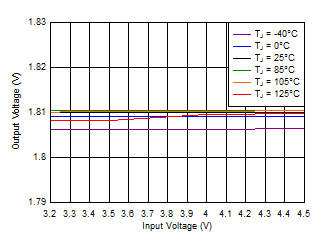
| IOUT = 0 mA |
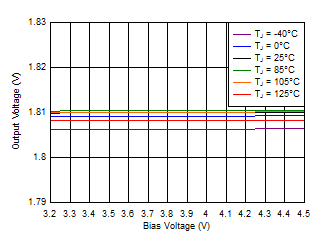
| IOUT = 0 mA |

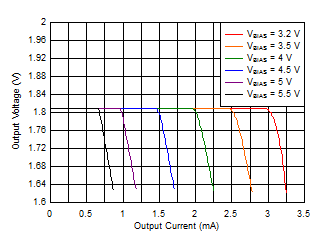
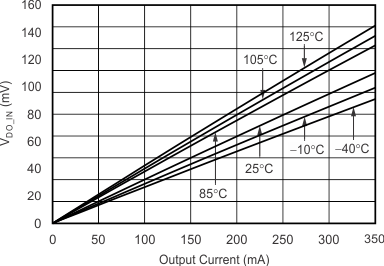
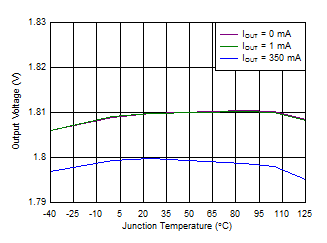
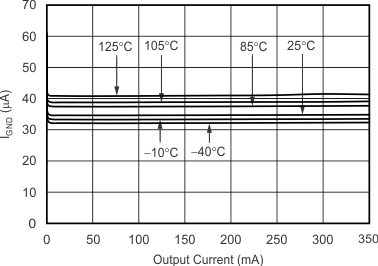

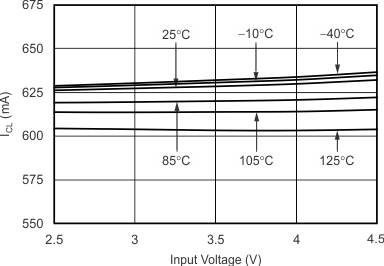
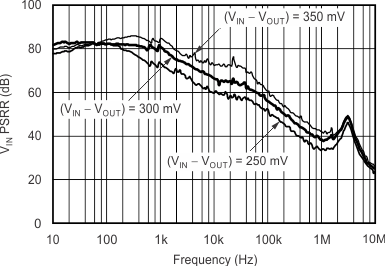
| IOUT = 350 mA |

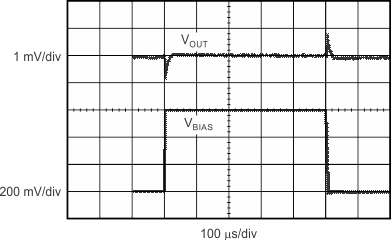
| VIN = 2.3 V | VOUT = 1.8 V | VBIAS = 3.2 V to 3.8 V |
| VBIAS slew rate = 600 m/μs | IOUT = 350 mA | |
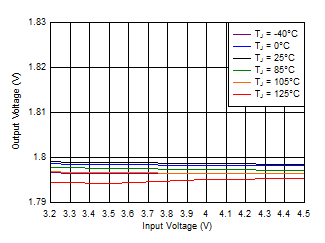
| IOUT = 350 mA |
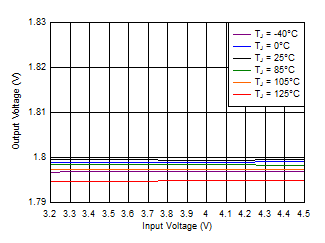
| IOUT = 350 mA |
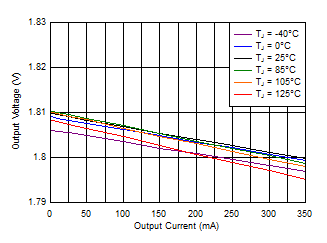

| VBIAS = 3.2 V |
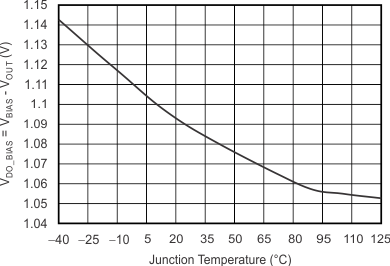
| VOUT = VOUT(NOM) – 0.1 V | IOUT = 350 mA | |
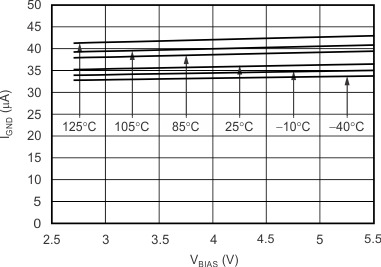
| IOUT = 1 mA | ||
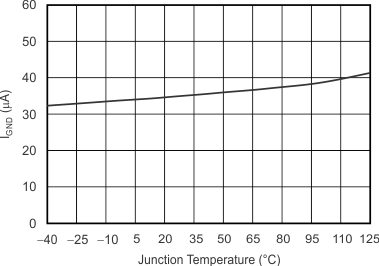
| IOUT = 350 mA |
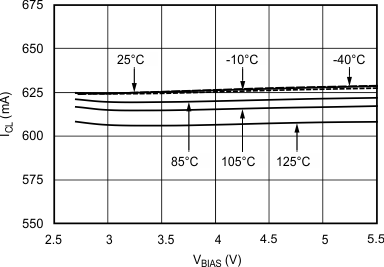

| VIN – VOUT = 0.5 V, VBIAS – VOUT = 1.4 V |
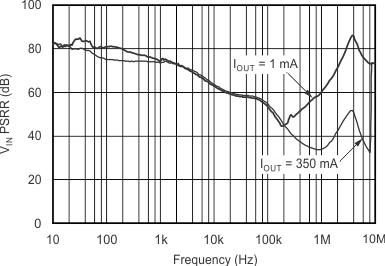
| VIN – VOUT = 0.5 V | VBIAS – VOUT = 1.4 V |

| VIN = 2.1 to 2.5 V | VOUT = 1.8 V | VBIAS = 3.2 V |
| VIN slew rate = 1 V/μs | IOUT = 350 mA |

| VIN = 2.3 V | VOUT = 1.8 V | VBIAS = 3.2 V |
| tRISE = 1 μs |